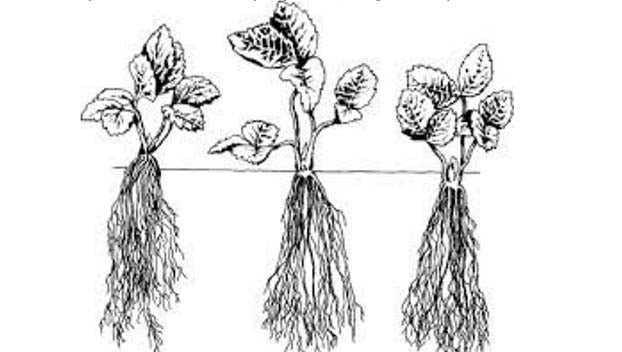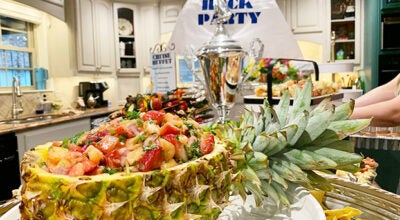MASTER GARDENER — See how strawberries and garlic are ideal companions
Published 12:04 am Thursday, September 1, 2022

- Interplanting strawberries and garlic utilizes its pungent aroma as a natural pest and fungus deterrent. (littleyellowwheelbarrow.com)
|
Getting your Trinity Audio player ready...
|
Last week’s article reviewed garlic (allium sativum) varieties, which grow well in our climate.
This week I want to share information on a wonderful companion plant to interplant with garlic: strawberries!
Some gardeners would never consider companion planting strawberries with garlic because they plant strawberries in spring. But is spring really the best time of year to plant strawberries in Southeast Texas?
The short answer is no, but let me provide a more detailed explanation why spring isn’t the best time to plant strawberries if you want a bountiful harvest!
We are all familiar with the saying, “everything’s bigger in Texas,” which likely originated as a reference to the state’s vast geographical area, but it could be true of your strawberry harvest, if you know how to “work around” Texas’s blistering summer temperatures!
Once summer arrives, strawberries (Fragaria ananassa) fade quickly, becoming withered crisps, which difficult keep viable during our lengthy summers.
Fall and winter’s balmy weather provides an exceptional opportunity for gardeners to grow strawberries.
Fall planting, offers protection from summer’s heat, allowing gardeners the prospect of a crop of strawberries much earlier than gardeners in other areas of the country.
Annual vs. Perennial
Strawberries are hardy perennials in USDA hardiness zones 5 to 8, meaning they can survive many growing seasons.
However, in USDA zones 9 and greater, strawberries are grown as cool-season annuals, which means they are planted during fall, produce fruit in spring, removed in summer, and replaced with new plants the following fall.
In the southeast, it is best to plant strawberries in late October through mid-December. Keep a row cover or two handy, just in case newly planted strawberries need some added protection from strong winds or cold temperatures.
Strawberries fall into two fruit-bearing categories: June-bearing and ever-bearing.
June-bearing cultivars primarily develop flowers in the early spring from buds developed during the previous fall or under short-day conditions.
Ever-bearing usually produce fruit under long-day conditions. Ever-bearing do not perform well in our locale. Strawberry varieties which grow best in Southeast, Texas: Chandler, Douglas, and Sequoia.
Anticipate each strawberry plant to produce up to one quart of strawberries within a 3-to-4-week period. Be prepared for your harvest.
Soil, Planting and Interplanting
Strawberries require full sun and well-drained, neutral to slightly acidic soil, preferring a soil pH between 6.5 and 7. Strawberry plants grow well when planted in raised beds or rows, which improves drainage and air circulation.

The center plant demonstrates the correct way to plant a strawberry plant without planting the crown below the soil surface. (Travis-TX.tamu.edu).
Space rows 12 inches apart, and individual plants 12 inches apart within the rows. Soak the roots in water for an hour, then trim to 6 inches in length. Spread the roots and cover completely with soil, taking care not to plant the crown.
Once planted, interplant strawberries with garlic cloves, 4 to 6 inches away from each strawberry plant. Another way to interplant garlic is in a central row, spacing cloves 3 to 4 inches apart, 2 inches deep, then plant strawberries 5 to 6 inches from center on either side of the row.
Fertilization, Watering, Mulch and Pests
Strawberries enjoy 5-10-10 fertilizer at planting time, so incorporate 2 cups fertilizer into the soil for each 10-foot planted row. In spring, side dress plants with more fertilizer every three weeks during the growing season.
Strawberries are shallow rooted, avoid allowing the roots to dry out. They perform best when provided uniform irrigation.
Strawberry plants require daily watering for the initial two weeks after planting to encourage root growth, then reduce watering frequency, but ensure the soil remains consistently moist.
Strawberries need to be mulched immediately after planting to reduce weeds and maintain soil moisture. Take it from my personal experience, do not use wheat straw as mulch, as it contains wheat seeds which easily germinate throughout winter.
I had to weed 4 strawberry beds, daily last winter. Pine straw is the best mulch to use, placing a 2-to-3-inch layer around each plant while also covering planted garlic cloves. Remove weeds over the course of fall and winter to remove competition for soil nutrients.
Birds, spider mites, slugs, snails and white grubs are major pests of strawberries. Bird netting is a useful tool control birds and keep them off your fruit.
Monitor the strawberries regularly, checking for disease, insects, and other pest problems.
Leaf spots and grey mold are common diseases of strawberries. Be warned, slugs and snails will wreak havoc on strawberry plants, especially fruit. Be prepared, I use a commercial product, Sluggo which is safe to use around pets, wildlife and doesn’t harm the environment as it made of iron phosphate, which occurs naturally in the soil. Garlic will help to address some of these pests naturally.
Let’s grow ourselves a greener, more sustainable world, one plant at a time.
John Green is a Certified Texas Master Gardener. If you have gardening questions or need more information, contact the Orange County Master Gardeners Helpline at 409-882-7010 or visit txmg.org/orange, Orange County Texas Master Gardeners Association on Facebook or email extension@co.orange.tx.us.





